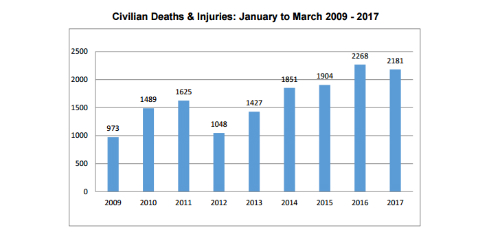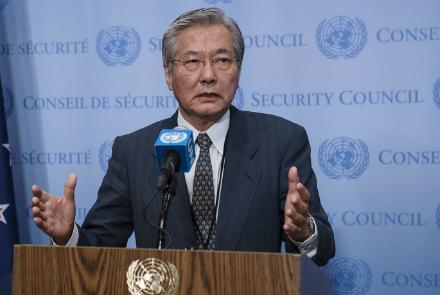In a new report issued Thursday, the UN Mission in Afghanistan (UNAMA) called on all parties to the conflict to take immediate and concrete measures to better protect civilians from harm, as the latest data for 2017 shows continued high numbers of civilian casualties.
“It is civilians, with increasing numbers of women and children, who far too often bear the brunt of the conflict,” said Tadamichi Yamamoto, the Secretary-General’s Special Representative for Afghanistan.
“With the so-called fighting season imminent, I appeal to all parties to take every measure possible to prevent unnecessary and unacceptable harm to Afghan civilians.”
In the first quarter of 2017, UNAMA documented 2,181 civilian casualties (715 dead and 1,466 injured), a four percent decrease compared to the same period in 2016. Civilian deaths decreased by two per cent while civilian injuries decreased by five per cent, it said adding that “consistent with trends in 2016, ground engagements continued to cause most civilian casualties, followed by improvised explosive devices, as well as suicide and complex attacks.”
The decrease in civilian casualties recorded by UNAMA is chiefly attributable to a 19 percent reduction in civilian deaths and injuries caused by ground engagements between pro-government forces and anti-government elements, according to the report.
While UNAMA welcomes such a decrease and all efforts to protect civilians, it notes the record levels of internal displacement within Afghanistan during 2016 and that the reduction in numbers may be related to the movement of civilians from several areas severely affected by conflict, the report stated.
Notwithstanding this decrease, ground fighting remained the leading cause of civilian casualties - accounting for 35 per cent of all civilian casualties.
The report pointed out that Kabul province had the highest number of civilian casualties due to suicide and complex attacks in Kabul city, followed by Helmand, Kandahar, Nangarhar and Uruzgan provinces.
“Anti-government elements caused 62 percent of civilian casualties – 1,353 civilian casualties (447 dead and 906 injured), reflecting a five percent increase compared to the same period in 2016,” the report said.
“Anti-government elements continued to target civilians intentionally and deploy indiscriminate tactics in areas with a civilian presence – in clear violation of their obligations under international humanitarian law. UNAMA documented attacks targeting civilian government employees, tribal elders, Muslim Shi’a mosques, humanitarian de-miners, NGO workers and civilians perceived to be government supporters,” it said.
“During an armed conflict, the intentional killing and injuring of civilians is a war crime” said Yamamoto.
“Anti-government elements must stop this deplorable practice and everybody must apply – and respect – the definition of ‘civilian’ provided by international humanitarian law,” he said.

Suicide and complex attacks continued to cause record levels of civilian harm. UNAMA recorded a five percent increase in civilian casualties from these tactics – 374 civilian casualties (108 dead and 266 injured) – accounting for 17 percent of all civilian casualties.
UNAMA attributed 21 per cent of civilian casualties to pro-government forces – 451 civilian casualties (165 dead and 286 injured) – a decrease of two per cent compared to the same period in 2016.
In the report, UNAMA is extremely concerned by increases in both child and women civilian casualties, particularly deaths.
The mission recorded a 24 percent increase in women civilian casualties, documenting 273 women casualties (88 dead and 185 injured) due to increases in women killed or injured by aerial operations and suicide and complex attacks. Conflict-related deaths of women increased by 54 percent while the number of injured women increased by 13 per cent.
Also in the first quarter, the mission recorded 735 child casualties (210 dead and 525 injured), a three percent increase compared to the same period in 2016. Child deaths increased by 17 percent while child injuries decreased by one percent. Children comprised 34 percent of all civilian casualties during the first quarter.
Increases in child casualties from aerial operations and improvised explosive devices, in conjunction with high numbers of children killed or injured by unexploded ordnance, drove the rise in child casualties, the report stated.
“The 17 percent increase in child casualties reflects the failure of parties to the conflict to take adequate precautions to protect civilians, including through marking and clearing unexploded ordnance after fighting ends,” said Danielle Bell, UNAMA’s Human Rights Director.
“These numbers represent the lives of 735 girls, boys and infants – 735 stories of death, maiming, physical pain, emotional trauma and grief. Parties must act now to protect children in 2017,” she said.


